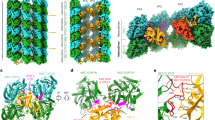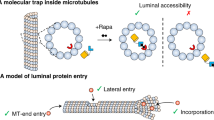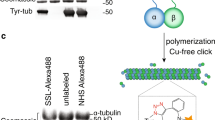Abstract
BORISY and Taylor have demonstrated a correlation between the presence of the colchicine-binding protein, tubulin, and the microtubular system of eukaryotic cells1. Tubulin assembles in vitro into microtubules when a brain homogenate is warmed to 37 °C and is supplied with a cofactor, GTP (refs 2 and 3). These microtubules dissociate into tubulin subunits when the solution is chilled to 0 °C (refs 3 and 4), or Ca2+ is introduced2,4. Tubulin can thus be purified by repeated cycles of assembly and disassembly4,5. We have found, and others report similarly6–10, that some very high molecular weight polypeptides copurify with the tubulin in these conditions.
This is a preview of subscription content, access via your institution
Access options
Subscribe to this journal
Receive 51 print issues and online access
$199.00 per year
only $3.90 per issue
Buy this article
- Purchase on SpringerLink
- Instant access to full article PDF
Prices may be subject to local taxes which are calculated during checkout
Similar content being viewed by others
References
Borisy, G. G., and Taylor, E. W., J. Cell Biol., 34, 525–533; 535–548 (1967).
Weisenberg, R. C., Science, 177, 1104–1105 (1972).
Borisy, G. G., and Olmsted, J. B., Science, 177, 1196–1197 (1972).
Borisy, G. G., Olmsted, J. B., Marcum, J. M., and Allen, C., Fedn Proc., 33, 167–174 (1974).
Shelanski, M. L., Gaskin, F., and Cantor, C. R., Proc. natn. Acad. Sci. U.S.A., 70, 765–768 (1973).
Cande, W. Z., Snyder, J., Smith, D., Summers, K., and McIntosh, J. R., Proc. natn. Acad. Sci. U.S.A., 71, 1559–1563 (1974).
Borisy, G. G., Marcum, J. M., Olmsted, J. B., Murphy, D. B., and Johnson, K. A., Ann. N. Y. Acad. Sci., 253, 107–132 (1975).
Burns, R. G., and Pollard, T. D., FEBS Lett., 40, 274–280 (1974).
Gaskin, F., Kramer, S. B., Cantor, C. R., Adelstein, R., and Shelanski, M. L., FEBS Lett., 40, 281–286 (1974).
Dentler, W. L., Granett, S., and Rosenbaum, J. L., J. Cell Biol., 65, 237–241 (1975).
Laemmli, U. K., Nature, 227, 680–685 (1970).
Kirschner, M. W., Williams, R. C., Weingarten, M., and Gerhart, J. C., Proc. natn. Acad. Sci. U.S.A., 71, 1159–1163 (1974).
Weingarten, M., Suter, M. M., Littman, D. R., and Kirschner, M. W., Biochemistry, 13, 5529–5537 (1974).
Weingarten, M. D., Lockwood, A. H., Hwo, S.-Y., and Kirschner, M. W., Proc. natn. Acad. Sci. U.S.A., 72, 1858–1862 (1975).
Luduena, R. F., and Woodward, D. O., Proc. natn. Acad. Sci. U.S.A., 70, 3594–3598 (1973).
Author information
Authors and Affiliations
Rights and permissions
About this article
Cite this article
KEATES, R., HALL, R. Tubulin requires an accessory protein for self assembly into microtubules. Nature 257, 418–421 (1975). https://doi.org/10.1038/257418a0
Received:
Accepted:
Issue date:
DOI: https://doi.org/10.1038/257418a0
This article is cited by
-
Making sense of the multiple MAP-2 transcripts and their role in the neuron
Molecular Neurobiology (1998)
-
Preferential binding of hog brain microtubule-associated proteins to mouse satellite versus bulk DNA preparations
Nature (1978)
-
Ambiguous effects of colchicine and vincristine upon A2-cell response to arginine
Diabetologia (1978)
-
A search for in vivo factors in regulation of microtubule assembly
Nature (1977)
-
Polymerising ability of C6 glial cell microtubule protein decays much faster than its colchicine-binding activity
Nature (1977)



